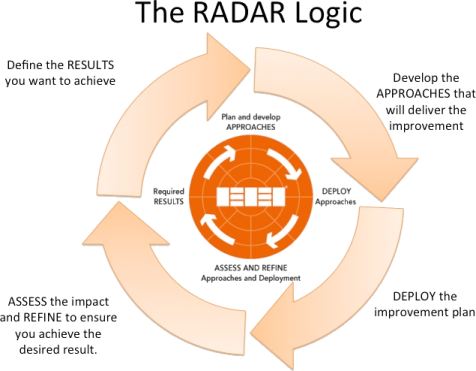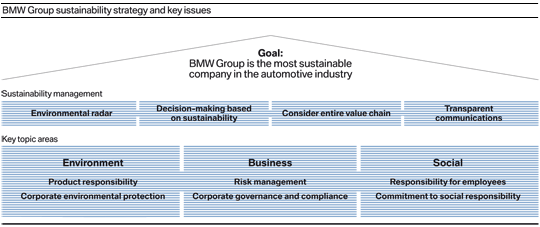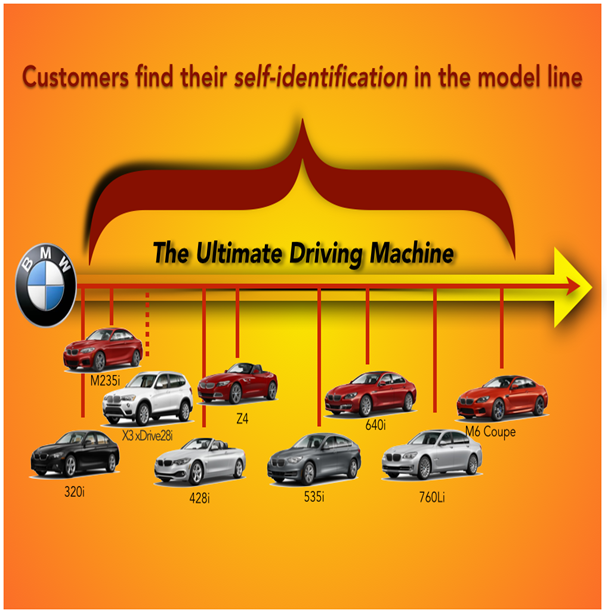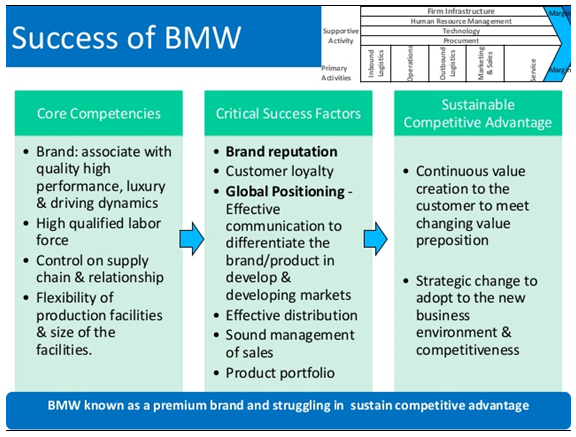Introduction
The BMW is among the largest manufacturers of cars and motorcycles based in Germany. It exports its automobile products in more than 150 countries across the world. To maintain high-quality productions and meet the demands of a huge market share, the business department has created policies to customize parts of their products. Through innovation and technology, the company has continued to create cars that attract huge demands all over the world. In the year 2015, the BMW became one of the EFQM award winners. The success of the company stemmed from the effective application of the business excellence model.
The objective of this study is to:
- Illustrate the EFQM model.
- Describe the success of the BMW group through the application of the EFQM model.
- Suggest further improvement in the performance of the BMW Group.
The EFQM Model
Both private and public organizations in the European context face various challenges. There is an increased pressure to compete in the global arena and limited resources. It implies that all business organizations have a collective responsibility to secure their future prosperity. The EFQM is a business excellence model that encourages the cooperation, innovation, and collaboration necessary to achieve the firm’s objectives (Suárez et al. 2014). In order to maintain a competitive edge in any industry, an organization must continue to innovate and improve.
Assessment Tool
Business organizations must have effective understanding, balancing, and management of the shareholders’ needs and expectations (Suárez et al. 2014). The EFQM model is an approach that helps in understanding and managing the complexity. The leading organizations develop the model to simulate the continuous improvement of their business operations (Moeller 2001). It allows the stakeholders to understand the relationship between the activities of their organization and the results it attains. The EFQM model consists of three sets of integrated elements. The first is the fundamental concepts of excellence, which define the key principles of having a sustainable excellence in an organization. The second one is the criteria, which provides a framework that converts these concepts and thoughts into practices. The third element is RADAR logic, shown in figure 1, which enhances systematic improvement throughout the organization (Moeller 2001).

The Process Enablers
The benefit of the model is that it is applicable to any organization irrespective of the size and industry. It takes into account various concepts unique to every business and industry. It also provides a common language for the management and stakeholders to share knowledge and experiences regarding the organization (Moeller 2001). The concepts illustrated in this framework describe the attributes of the organizational culture that leads to business excellence. It serves as a tool with a common language for the top management to initiate business strategies.
The process enablers of the EFQM model shown in figure 1 include:
- Leadership.
- Policy and strategy.
- People.
- Partnership and resources.
- Processes, products, and services.
- Customer results.
- People results.
- Society results.
- Key performance results.

The BMW Overview
Founded in 1916 as the BFW, the BMW was established in 1918. The BMW AG is the parent company that controls operations of the BMW Group. The company’s main business is to develop, manufacture and sell engines and complete vehicles of the same brand. Its business operations are divided into automobiles, motorcycles, and financial services among other entities (Annual Report 2015). The BMW Group is one of the world’s successful manufacturers of cars and motorcycles. The three of its strongest brands in the industry are BMW, Rolls-Royce, and MINI. Figure 3 shows the company’s sustainability management structure.

Vision
2015
To continue with their relenting efforts of manufacturing premium automobiles with uncompromising quality.
2020
To become the leading provider of premium vehicles and motorcycles.
Mission
To be the world’s leading manufacturer of premium products and services.
Values
To enhance value-based creativity, innovation, and research through an effective management strategy.
Strategic Objectives
- To create a stronger position in the future than the moment.
- To produce and distribute environmentally-friendly vehicles.
- To maintain a competitive edge in the major market segments.
- To increase sales of its products and services across the world.
- To help the society through their CSR strategy.
Journey of BMW Towards Excellence
With approximately one century in the automobile industry, BMW has come a long way in implementing the EFQM model to improve its business operations.
- The company started as an aircraft manufacturing company.
- In 1923: shifted operations to manufacturing of motorcycles.
- In 1959: it faced a serious financial crisis but switched to the automobile industry instead of liquidating its assets.
- In 1966: made their first car with a brand name “Dixi”, which was received well in the market.
- In 1992: they acquired a large industrialized studio in California for production and development in the United States.
- In 2012: voted the most successful automobile producer with 1 845 186 cars and 117 109 motorcycles.
- Produces vehicles and motorcycles using high standard quality
- Employed more than 122,200 workers across the as of 2015. As a result, the company has changed the lives of many people in the society.
- Provide premium products and services through their affiliate brands such as MINI, Rolls-Royce, and MINI.
- In 2015: BMW AG became an EFQM award winner.
The Implementation of EFQM in BMW
What BMW has Done
The BMW applies a value-based management system, with a focus on profitability and growth. Through the company’s management, it increases the value of stakeholders and safeguards the employees’ welfare. It ensures the generated profit exceeds equity costs and debt capital. As a result, the company can expand its activities in innovative research and production sectors to meet the current demands in the automobile industry (Vuskane 2010). The internal management system of the BMW Group has a multilayered structure with various levels of aggregation. The value-drivers approach has a positive impact on the company’s profitability (August-Wilhelm 2006).
The BMW Activities Based on the EFQM Model
Strategy
The company is committed to manufacturing and distributing outstanding products and services. It fights to gain a high competitive edge and maximum market share in the automobile market across the globe (Appendix II). The BMW Group has been putting unrelenting efforts to create an excellent brand image among its global customers (Annual Report 2015). In order to satisfy specific needs in various local and regional markets, the corporation adopted both centralized and integrated brand strategies in different countries (Vuskane 2010). The approach promotes the global brands in regional markets through localized marketing strategy.
People
The target customers throughout the world are people with high incomes. The major target markets of the company’s brands are concentrated in developed and industrialized nations (Annual Report 2015). Lifestyles of people in these countries conform to the current trends in the automobile industry. Therefore, the company strives to produce outstanding cars and motorcycle to increase sales and capture huge market shares.
Partnership and Resources
To meet the specific need of customers, BMW has partnered with other business entities across the world. For instance, it created a business relationship with MINI to develop some of the luxurious car brands in the market. The partnership enhanced low production costs of strong residual values (August-Wilhelm Scheer 2006). The brands made through the business collaboration have continued to create a compelling proposition in the automobile industry. The partnership approach is aimed at expanding its global market by improving customer services through logistics.
Leadership
The EFQM defines the customer as the last arbiter of product and service quality. Therefore, the fundamental concept of business excellence is the customer. The design processes and management system of the BMW Group enables it to understand, monitor and evaluate the needs and expectations of its customers (Vuskane 2010).
Processes, Products, and Services
As a result, the company has categorized its products into luxury, premium and small products and related services. Therefore, in the three categories, it addresses the customers’ specific needs and expectations by creating innovative cars and motorcycles. The structural classification of customers helps the organization to evaluate customer-related data and customer results (Moser 2007).
Customer results
- Achieved customer loyalty by addressing the current automobile needs (Appendix I).
- Attained huge market share through customer satisfaction.
- Promoting international brands through localized marketing to reach new customers.
People Results
- Employs more than 122,000 works who change the living standards of the society (Annual Report 2015).
- Employed innovative works in the production and marketing sectors to create and distribute premium products and services.
Society Results
- Contributes positively towards environmental conservation through its SCR strategy.
Business Results
- Increased sales across Europe by 9.4% in 2015.
- Sales records increased by 6.4% in the 2014/2015 fiscal year.
- Established 13 stations across the world to develop innovative strategy (Annual Report 2015)
Benefits and Limitations of the EFQM Model
Benefits
- Enhances efficient data management.
- Improved operations.
- Improve customer services and change management.
- High returns on investment motivate stakeholders.
Limitations
- Difficulty in using documented evidence.
- Inadequate information about sustainability
- Assessment report does not provide the management with a clear direction.
Discussions and Conclusion
The BMW Group has consistently manufactured excellent vehicles with a focus on quality. Through innovative leadership, it has decentralized some of its operations to regional markets in order to meet customer demands. Using the EFQM model has helped in evaluating the excellent success of the business. The model assesses the business success in terms of leadership, people, strategy, partnership & resources, process, products & services, and results.
The management understands, monitors, and evaluates its customer demands through integration. It supplies vehicles in both developed and developing countries. To meet the specific demands of customers, the BMW Group classified its products as luxury, premium, and small vehicles. The approach has helped in expanding its market shares across the world, hence high profitability. In conclusion, the BMW has managed to retain a high competitive edge and huge market share because of its uncompromising business policies on quality.
References
Annual Report 2015, BMW Group. Web.
August-Wilhelm, K 2006, Agility by ARIS Business process management: yearbook business process excellence 2006/2007, Heidelberg, Springer-Verlag. Web.
Moeller, J 2001, “The EFQM excellence model: German experiences with the EFQM approach in health care.” International Journal for Quality in Health Care, vol. 13, no. 1, pp. 45-49. Web.
Moser, K 2007, Mass customization strategies- development of a competence-based framework for identifying different mass customization strategies, North Carolina, Lulu Press Inc. Web.
Suárez, E, Roldán, L, & Calvo-Mora, A 2014, “A structural analysis of the EFQM model: an assessment of the mediating role of process management.” Journal of Business Economics and Management, vol. 15, no. 5, pp. 862-885. Web.
Vuskane, L 2010, BMW business strategy-an overview, Norderstedt, GRIN Verlag. Web.
Appendices


